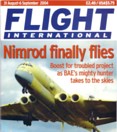|
Aeronautics
 "Radical
and fundamental progress in Aeronautics is achievable.
In fact, much of the work has already been done and
is in the Public Domain. It is simply time to apply
it. "Radical
and fundamental progress in Aeronautics is achievable.
In fact, much of the work has already been done and
is in the Public Domain. It is simply time to apply
it.
It
is widely acknowledged that there is a malaise in the
Aerospace Industry as described in Aviation Week's series
of articles "Aerospace in Crisis". This malaise
will lead to increasing stagnation and decline if this
direction is not changed. The industry has become in
many way conservative and risk averse.
It
is also an acknowledged problem that engineering graduates
increasingly see little to interest them in aerospace
and are attracted instead to the apparently more exciting
IT industry. ("Brain Drain Threatens Aerospace
Vitality, AW&ST, 24/7/00). Indeed, the decline in
students studying for science and engineering degrees
in the western world is a problem for all industries.
The age profile of aerospace engineers continues to
grow older, particularly in the United States. Within
10 years, many experienced engineers will have retired
and there will be nobody to replace them. Instead, one
can see design work being subcontracted by major US
aerospace firms to inexperienced new design centres
in Europe, Japan or Russia. This will break up the central
cores of knowledge that still exist on how to design
and build a commercial airliner: instead, we see a shift
to centres that specialise in a particular sub-system.
The
front cover of Flight International, 31st August 2004
proclaimed:
"Nimrod
finally flies. Boost for troubled project as BAE's mighty
hunter takes to the skies".
The
front cover photograph depicts an unpainted Nimrod MRA4
taking off.
Inside,
Flight reported that:
"The first prototype of BAE Systems Nimrod MRA4 aircraft
had its debut flight last week ... more than a year
after the next-generation aircraft was scheduled to
enter service under a 1996 contract. The UK originally
planned to acquire 21 MRA4s remanufactured from Nimrod
MR2s .... the RAF announced it plans to cut its already
reduced commitment for 18 aircraft to around 12".
"A
restructuring of the programme has identified March
2009 as the new entry into service target for the type
depending on the outcome and timing of a production
decision".
The
Nimrod is a derivative of the Comet airliner that first
flew on the 27th July 1949. The Comet was the first
commercial jet airliner ever to fly, ushering in the
Jet Age.
55
years later, the RAF is still using the same basic Comet
airframe design for its latest reconnaissance aircraft
- which will not enter service till 60 years after the
airframe first flew and 13 years after the upgrade contract.
While
there have been incremental improvements in subsonic
aerodynamic design since the 1950s, notably the supercritical
wing, the basic design philosophy has remained unchanged.
This is not for want of improved design concepts.
In
the Supersonic field, there is no denying that progress
has completely stagnated, with still no successor to
Concorde flying 35 years after its first flight.
Why
has there been so little progress since the 1960s?
Is
it true that we have already reached the limits of the
physically possible and therefore future progress will
only ever be incremental and marginal?
Or
are we merely being myopic, trapped by our preconceived
ideas dating back to the 1830s? Is radical progress
not still achievable leading to a quantum jump in our
aeronautical capabilities if we are willing to take
risks again?
The
answer is yes - radical and fundamental progress is
achievable. In fact, much of the work has already been
done and is in the public domain. It is simply time
to apply it.
MIR
is carrying out research to apply these already known
technologies in the following areas:
- Next
Generation Supersonic Aircraft
Design
- The
Lifting Body Aircraft
- Applications
of the Coanda Effect
- Advanced
Propulsion Systems
- New
Computational Wave Modelling
tools to replace CFD.
|
